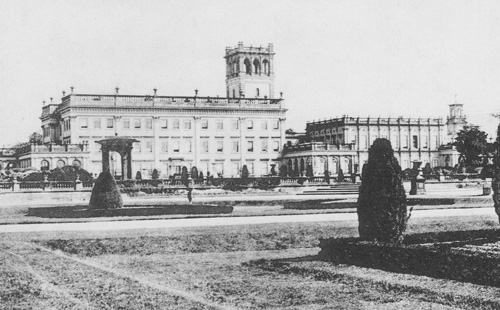Trentham Hall
Staffordshire
| Location | Trentham | ||
| Year demolished | 1912 | ||
| Reason | Spoilt by urban development | ||
| See all images: | Gallery | ||
| << Back to the main list |
The Staffordshire seat of the Dukes of Sutherland - a magnificent Victorian, Italianate house - was eventually doomed by the relentless expansion of the nearby urban areas. If it had survived it would have easily been one of the truly great houses of England.
 Today, all that remains of this fine house is a beautiful public garden, a selection of buildings, a gallery and the parish church. The site had an extensive history first as an Augustinian Priory and then as convent. It is also known that a large Elizabethan house was built in the 1630s in the same location but it was probably demolished during the building of the Georgian Trentham Hall. This earlier house had been much plainer, built in the eighteenth-century, and had sat in extensive parks which had been designed and created between 1768 and 1778 by Capability Brown and Henry Holland. Even the River Trent was incorporated into the designs and was diverted to flow into the lake.
Today, all that remains of this fine house is a beautiful public garden, a selection of buildings, a gallery and the parish church. The site had an extensive history first as an Augustinian Priory and then as convent. It is also known that a large Elizabethan house was built in the 1630s in the same location but it was probably demolished during the building of the Georgian Trentham Hall. This earlier house had been much plainer, built in the eighteenth-century, and had sat in extensive parks which had been designed and created between 1768 and 1778 by Capability Brown and Henry Holland. Even the River Trent was incorporated into the designs and was diverted to flow into the lake.
The house was dramatically changed when the second Duke of Sutherland commissioned the famous architect Sir Charles Barry, who was also working on the rebuilding of the Houses of Parliament, to produce a much grander statement of the Duke's great wealth as the largest landowner in Britain at the time.
For over ten years from the mid-1830s, Barry extended and improved the house, adding a new block containing state bedrooms with dressing rooms and its own servants' quarters, a sculpture gallery and a 100ft high clock tower. New family quarters were also added with the new tower in the centre of the creation to provide a focus. A grand new main entrance with a portico which bore the family coat of arms, supported by stone life-sized wolves, was linked to a gallery from which the important guests could go straight to the state bedroom with other visitors being channelled off to the private family apartments. The spectacular conservatory led to the extensive gardens which were tended by 50 gardeners.
The interior was equally splendid. The first Duke of Sutherland had been a keen collector and had expended much effort in adding to the family's superb collection with even the breakfast-room being adorned with paintings by Poussin and Gainsborough. Despite the obvious grandeur the house is remembered as having a 'homely' feel to it - well-proportioned rooms helped in this respect.
Unfortunately it wasn't to last. By 1898, a profile in Country Life magazine highlighted that the lake at Trentham was now polluted by sewage from the nearby Potteries. Despite attempts to provide cleaner alternative sources, the lake became a blight on the entire estate. Abandoned by 1907, no-one would buy it and it could not even be given away - the County of Staffordshire and the Borough of Stoke-on-Trent were offered it for free in 1905 - and so it was pulled down in 1912. All that remains today are the curved west entrance front and the stable block with the grounds and buildings used for exhibitions and conferences. A tragic end to one of the most splendid of English houses built using the finest materials by one of our best architects and filled with some of best art, but sadly ruined by relentless urban expansion.
Further information on the current plans for the park is available from the official website: Trentham Estate